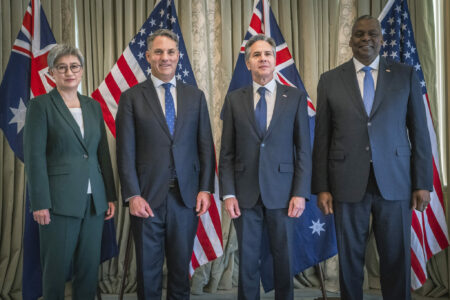Written by Dr. Binoy Kampmark
The AUSMIN 2023 talks held between the US Secretaries of State and Defense and their Australian counterparts, confirmed the increasing, unaccountable militarisation of the Australian north and its preparation for a future conflict with Beijing. Details were skimpy, the rhetoric aspirational. But the Australian performance from Defence Minister Richard Marles, and Foreign Minister Penny Wong, was crawling, lamentable, even outrageous. State Secretary Antony Blinken and Defense Secretary Lloyd Austin III could only look on with sheer wonder at their prostrate hosts.
Money, much of it from the US military budget, is being poured into upgrading, expanding and redeveloping Royal Australian Air Force (RAAF) bases in the Northern Territory city of Darwin, and Tindal, situated 320km south-east of Darwin, the intended to “address functional deficiencies and capacity constraints in existing facilities and infrastructure.” Two new locations are also being proposed at RAAF Bases Scherger and RAAF Curtin, aided by site surveys.
The AUSMIN joint statement, while revealing nothing in terms of operational details or costs, proved heavy with talk about “the ambitious trajectory of Enhanced Force Posture Cooperation across land, maritime, and air domains, as well as Combined Logistics, Sustainment and Maintenance Enterprise (CoLSME).” Additionally, there would be “Enhanced Air Cooperation” with a rotating “US Navy Maritime Patrol and Reconnaissance Aircraft in Australia to enhance regional maritime domain awareness, with an ambition of inviting likeminded partners to participate in the future.”
Further details have come to light about the money being spent by the Pentagon on facilities in Darwin. The unromantically titled FY22 MCAF Project PAF160700 Squadron Operations Facility at the RAAF Darwin base “includes the construction (design-bid-build) of a United States Air Force squadron facility at the … (RAAF) in Darwin, Australia.” The project is deemed necessary to add space “for aircrew flight equipment, maintenance and care, mission planning, intelligence, crew briefings, crew readiness, and incidental related work.” Some of the systems are mundane but deemed important for an expanded facility, including ventilating and air conditioning, water heating, plumbing, utility energy meters and sub-meters and a building automation system (HVAC Control system).
Correspondents from the Australian Broadcasting have gone further into the squadron operations facility, consulting US budget filings and tender documents to reveal cost assessments of $26 million (A$40 million). A further parking apron at RAAF Darwin is also featured in the planning, estimated to cost somewhere in the order of $258 billion. This will further supplement plans to establish the East Arm fuel storage facility for the US Air Force located 15 kilometres from Darwin that should be able to, on completion by September this year, store 300 million litres of military jet fuel intended to support US military activity in the Northern Territory and Indo-Pacific region.
According to the tender documents, the squadron operations facility also had a broader, more strategic significance: “to support strategic operations and to run multiple 15-day training exercises during the NT dry season for deployed B-52 squadrons.” The RAAF Tindal facility’s redevelopment, slated to conclude in 2026, is also intended to accommodate six B-52 bombers. Given their nuclear capability, residents in the NT should feel a suitable degree of terror.
Michael Shoebridge, founder and director of Strategic Analysis Australia, is none too pleased by this state of affairs. He is unhappy by Canberra’s reticence on US-Australian military arrangements, and none too keen on a debate that is only being informed by US-based sources.
“A public debate needs to be enabled by information and you can’t have a complete picture without knowing where the money is being spent.”
While it is hard to disagree with that tack, Shoebridge’s outfit, in line with such think tanks as the Australian Strategic Policy Institute, is not against turning Australia into a frontline fortress state ready for war. What he, and his colleagues take issue with, is the overwhelmingly dominant role the US is playing in the venture. Those in Washington, Shoebridge argues, seem to “understand the urgency we don’t seem to.” Rather than questioning Australia’s need for a larger, more threatening military capability to fight phantoms and confected foreign adversaries, he accepts the premise, wholeheartedly. Canberra, in short, should muck in more, pull its weight, and drum up Australian personnel for the killing.
Anthony Bergin, a senior fellow of Strategic Analysis Australia, teases out the idea of such mucking in, suggesting a familiar formula. He insists that, in order to improve “our national security, we should be looking at options short of conscription which wouldn’t be as hard to sell to the Australian people.” He thought the timing perfect for such a move.
“There’s now a latent appetite for our political leaders to introduce measures to bolster national resilience.”
This silly reading only makes sense on the assumption that the Australian public has been softened sufficiently by such hysterical affronts to sensibility as the Red Alert campaign waged in the Fairfax Press.
Options to add padding to Australia’s military preparedness include doubling or tripling school cadets and cadet programs of the “outdoor bound” type based in the regions. But more important would be the creation of a “national militia training scheme”. Bergin is, however, displeased by the difficulty of finding “volunteers of any kind”, a strange comment given the huge, unpaid volunteer army that governs the delivery of numerous services in Australia, from charities to firefighting.
Alison Broinowski, herself formerly of the Australian diplomatic corps, safely concludes that the current moves constitute “another step in the same direction – a step that the government has been taking a series of for years; accepting whatever the United States government wants to place on Australian soil.” More’s the pity that most details are to come from Washington sources, indicating, with irrefutable finality, Canberra’s abject subordination to the US imperium and its refusal to admit that fact.
Dr. Binoy Kampmark was a Commonwealth Scholar at Selwyn College, Cambridge. He currently lectures at RMIT University. Email: bkampmark@gmail.com






